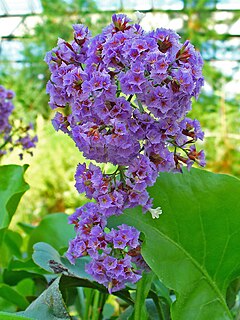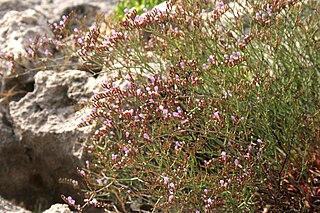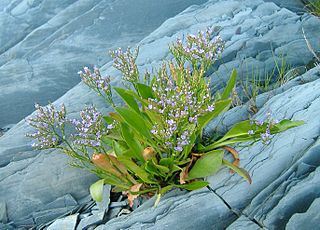
Limonium is a genus of 120 flowering plant species. Members are also known as sea-lavender, statice, caspia or marsh-rosemary. Despite their common names, species are not related to the lavenders or to rosemary. They are instead in Plumbaginaceae, the plumbago or leadwort family. The generic name is from the Latin līmōnion, used by Pliny for a wild plant and is ultimately derived from the Ancient Greek leimon.

Veratrum californicum is an extremely poisonous plant native to western North America, including the Sierra Nevada and Rocky Mountains, as far north as Washington and as far south as Durango; depending on latitude, it grows from near sea level to as high as 11,000 feet. It grows 1 to 2 meters tall, with an erect, unbranched, heavily leafy stem resembling a cornstalk. It prefers quite moist soil, and can cover large areas in dense stands near streams or in wet meadows. Many inch-wide flowers cluster along the often-branched top of the stout stem; they have 6 white tepals, a green center, 6 stamens, and a 3-branched pistil. The buds are tight green spheres. The heavily veined, bright green leaves can be more than a foot long.

Lycium californicum is a spreading shrub in the nightshade family known by the common names California boxthorn and California desert-thorn.

Delphinium californicum is a species of larkspur known as California larkspur. This wildflower is endemic to California, where it is a resident of the chaparral slopes of the San Francisco Bay Area and Central Coast.

Geranium californicum is a species of Geranium known by the common name California cranesbill. It is endemic to California, where it grows in the Sierra Nevada and coastal ranges in the southern part of the state.

Symphyotrichum frondosum is a species of flowering plant in the family Asteraceae native to western North America. Commonly known as short-rayed alkali aster, it is an annual or perennial herbaceous plant that may reach 140 centimeters tall.

Limonium sinuatum, commonly known as wavyleaf sea lavender, statice, sea lavender, notch leaf marsh rosemary, sea pink, is a Mediterranean plant species in the family Plumbaginaceae known for its papery flowers that can be used in dried arrangements.

Limonium arboreum is a species of sea lavender known by the common name tree limonium and siempreviva. It is endemic to the Canary Islands, where it is a plant of coastal habitat.

Limonium perezii is a species of Limonium known by the common names Perez's sea lavender and seafoam statice. It is also known as simply statice, sea lavender or marsh rosemary. It is native to the coasts of the Canary Islands but are widely used in gardens throughout the world.

Sisyrinchium californicum is a species of flowering plant in the iris family known by the common names golden blue-eyed grass, yellow-eyed-grass, and golden-eyed-grass. It is native to the west coast of North America from British Columbia to central California, where it grows in moist habitat, often in coastal areas.

Spergularia macrotheca is a species of flowering plant in the family Caryophyllaceae known by the common name sticky sandspurry. It is native to western North America from British Columbia to Baja California, where it grows in many types of moist coastal and inland habitat, often in alkaline and saline substrates. It may be found in marshes, alkali flats, beaches, meadows, seeps, and vernal pools. It is a perennial herb producing a narrow stem up to 40 centimeters long with a woody, thickened base and taproot. They may grow erect or prostrate across the ground. It is covered in sticky glandular hairs, especially in the inflorescence. The stems are lined with fleshy linear leaves, sometimes tipped with spines. The leaves are accompanied by triangular stipules up to a centimeter long each. Flowers occur in clusters at the end of the stem as well as in leaf axils. The small flowers have five pointed sepals and five oval white to lavender-pink petals. The fruit is a capsule containing tiny reddish brown, winged seeds.

Limonium ramosissimum, the Algerian sea lavender, is a species of sea lavender (Limonium) native to the Mediterranean region. Its specific epithet rāmōsissimum means "many-branched" in Latin.

Halodule uninervis is a species of seagrass in the family Cymodoceaceae. It is native to the western Pacific and Indian Oceans. Common names include narrowleaf seagrass in English and a'shab bahriya in Arabic.

Limonium narbonense is a species of sea lavender belonging to the family Plumbaginaceae.
The Kendall-Frost Mission Bay Marsh Reserve is a 20-acre University of California Natural Reserve System reserve on the northern shore of Mission Bay in San Diego County, California. Administered by UC San Diego, the site is owned by the University of California and managed for teaching and research.

Limoniastrum monopetalum, is a species of flowering plant in the family Plumbaginaceae that is native to between Europe, Northern Africa and Western Asia. It has been found in salt marshes, dunes and other coastal areas with high salinity levels. It has silver-grey or light green leaves on multi branching stems. At the ends of the stems are the summer blooming flowers, in shades of pink, purple, lavender and violet. It is known to be salt and drought tolerant, as well as having the ability to withstand some forms of soil pollution.
Statice limonium may refer to:

Goniolimon tataricum is a species of flowering plant in the genus Goniolimon, family Plumbaginaceae. It is called German statice, Tatarian sea-lavender, Tartarian statice or just statice. It is native to Albania, Algeria, Bulgaria, Greece, Kazakhstan, the North Caucasus, Romania, Southern Russia, Tunisia, Ukraine and the former Yugoslavia. It is planted in gardens as a border and ground cover, and also used in the cut flower industry.

Limonium vulgare, called common sea-lavender, is a species of flowering plant in the genus Limonium native to Atlantic parts of Europe from southwestern Sweden to southwestern Iberia and the Azores, and introduced elsewhere. A clumping perennial found in salt marshes and other maritime habitats, it is a probable species complex.

Limonium carolinianum, known variously as Carolina sealavender, canker root, ink root, marsh root, lavender thrift, American thrift, or seaside thrift, is a species of flowering plant native to the eastern shores of North America, from northern Mexico to Canada. It is a slow-growing perennial herb found in salt marshes and other maritime habitats. Its inflorescences are frequently harvested for use in cut flower arrangements.


















